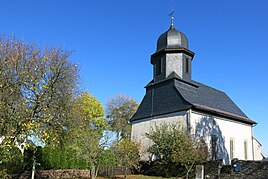Schweinbach (Leutenberg)
|
Schweinbach
City of Leutenberg
Coordinates: 50 ° 33 ′ 52 ″ N , 11 ° 24 ′ 24 ″ E
|
|
|---|---|
| Height : | 557 m above sea level NN |
| Residents : | 168 (Dec. 31 1996) |
| Incorporation : | January 1, 1997 |
| Postal code : | 07338 |
| Area code : | 036734 |
|
Holy Cross Church Schweinbach
|
|
Schweinbach is a small village in the Thuringian Slate Mountains . It is a district of the city of Leutenberg and lies west of the city in the district of Saalfeld-Rudolstadt .
geography
The place is in the north of a wide plateau, the Steinerne Heide, which extends between the Loquitz and Sormitz valleys . The houses are in a shallow hollow, surrounded by fields and forests. The highest point in the community, the Bühl, is 596 m high.
history
Schweinbach was probably founded in the 11th century - with reference to the colonization program of the Benedictine Abbey Saalfeld , the place name is of German origin, the first documentary mention was in 1398 (or 1378 - after Kahl) under the name Swymbach . The origin of the name refers to the village stream: "Schwinbach" - "Schwembach" and "Schweynbach" are spellings in the earliest documents about the place.
In the middle of the village are the remains of a small medieval fortification: in the middle of the 19th century, a double moat surrounded a tiny island heaped up in the center of the complex, it probably only offered space for a defense tower . Between the trenches, the excavation was piled up as a ring wall and probably crowned by a palisade ring . At the end of the 19th century the Schweinbachers had received permission to plan the western part of the castle grounds, the outer moat was filled with rubble. The system is therefore only preserved in small parts. Tradition reports that a "Countess von Leutenberg" lived in the castle.
The property in the village was divided into two aristocratic estates as early as the 15th century: The older manor appeared for the first time in 1453 as the property of the Lords of Lengefeld, who are known as court lords in the Edelhof von Laasen and in the neighboring towns of Arnsbach, Döhlen and Reschwitz. The family kept the estate until 1741, when it came to K. Erdmann von Reitzenstein. A few years later it was given to a Baroness von Speßhardt , and in 1808 the estate was divided up. The second property was sold or pledged even more frequently: in 1460 owned by a Matthias von Reitzenstein, it came to Christoph von Oberweimar through a branch of the Lords von Witzleben around 1534. The last known change of ownership took place in 1604 to Heinrich von Helldorf. Presumably it was then united with the Lengefeld possessions.
The village church will also have been built at the same time as the naming of the goods; a previous chapel may have stood under the protection of the castle. The place belonged to the Grafschaft Schwarzburg-Leutenberg and after its extinction from 1564 to 1918 to the supremacy of the Grafschaft or the Principality of Schwarzburg-Rudolstadt .
Cultural monument
- The remains of the castle site are protected as a ground monument.
- The church of the place is registered as a cultural monument. (see also list of cultural monuments in Leutenberg )
Web links
Individual evidence
- ^ Wolfgang Kahl : First mention of Thuringian towns and villages. A manual. 5th, improved and considerably enlarged edition. Rockstuhl, Bad Langensalza 2010, ISBN 978-3-86777-202-0 , p. 259.
- ↑ Comments on the chronicle of the place
- ↑ a b Curt Stuhlmann: Schweinbach - a castle site near people mountain in Thuringia . In: Criss-cross through Thuringia . Issue 7, 1926, ZDB -ID 17856-1 , p. 191-95 .

